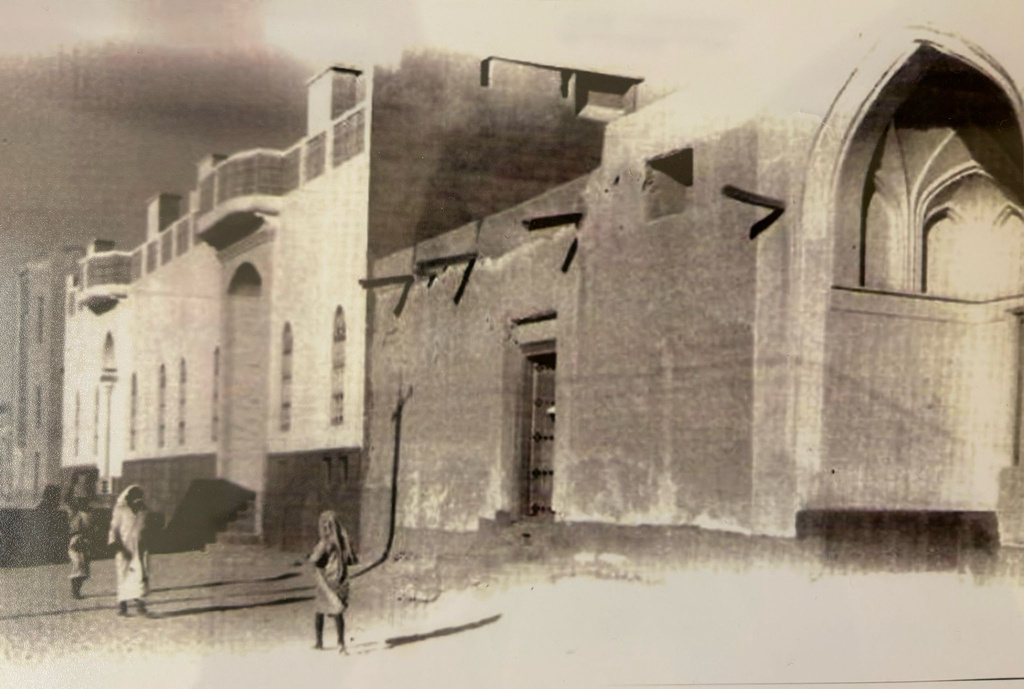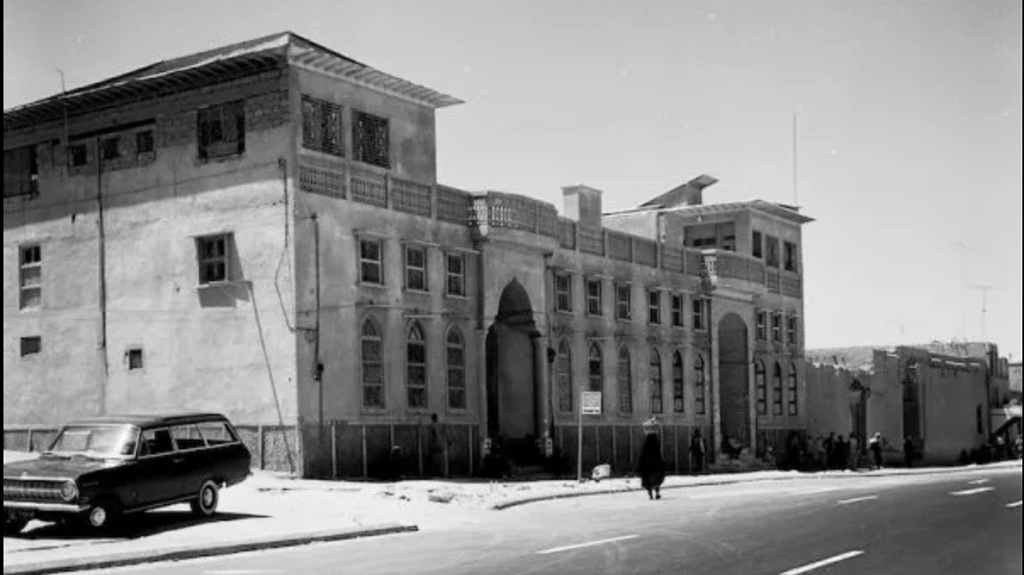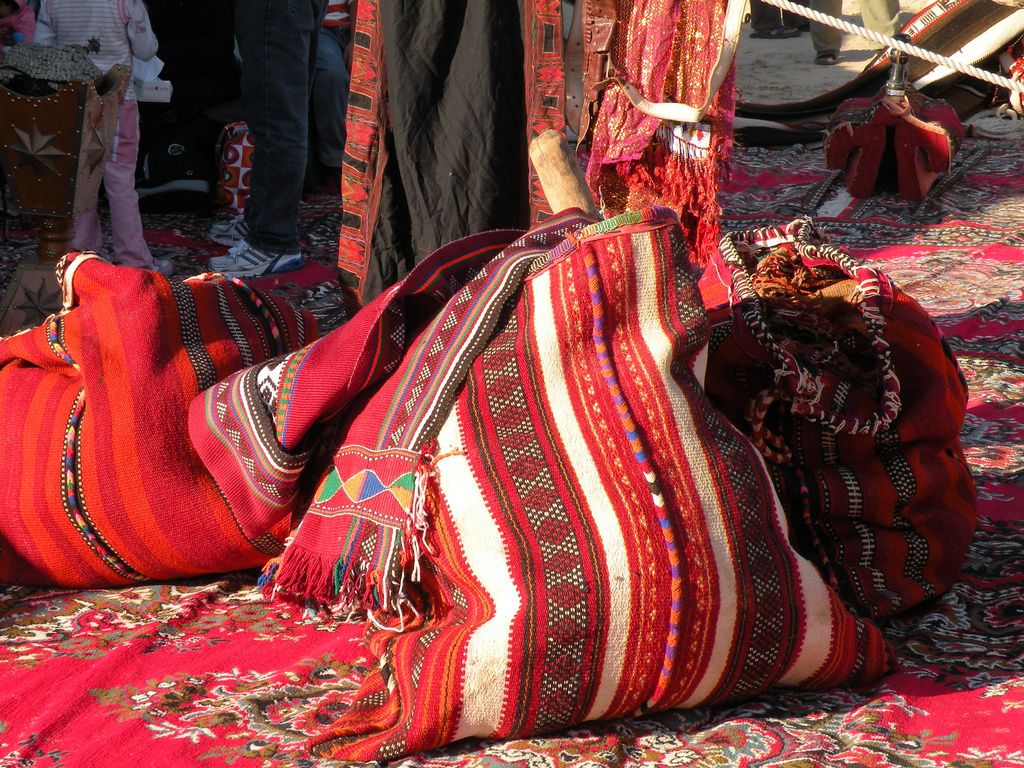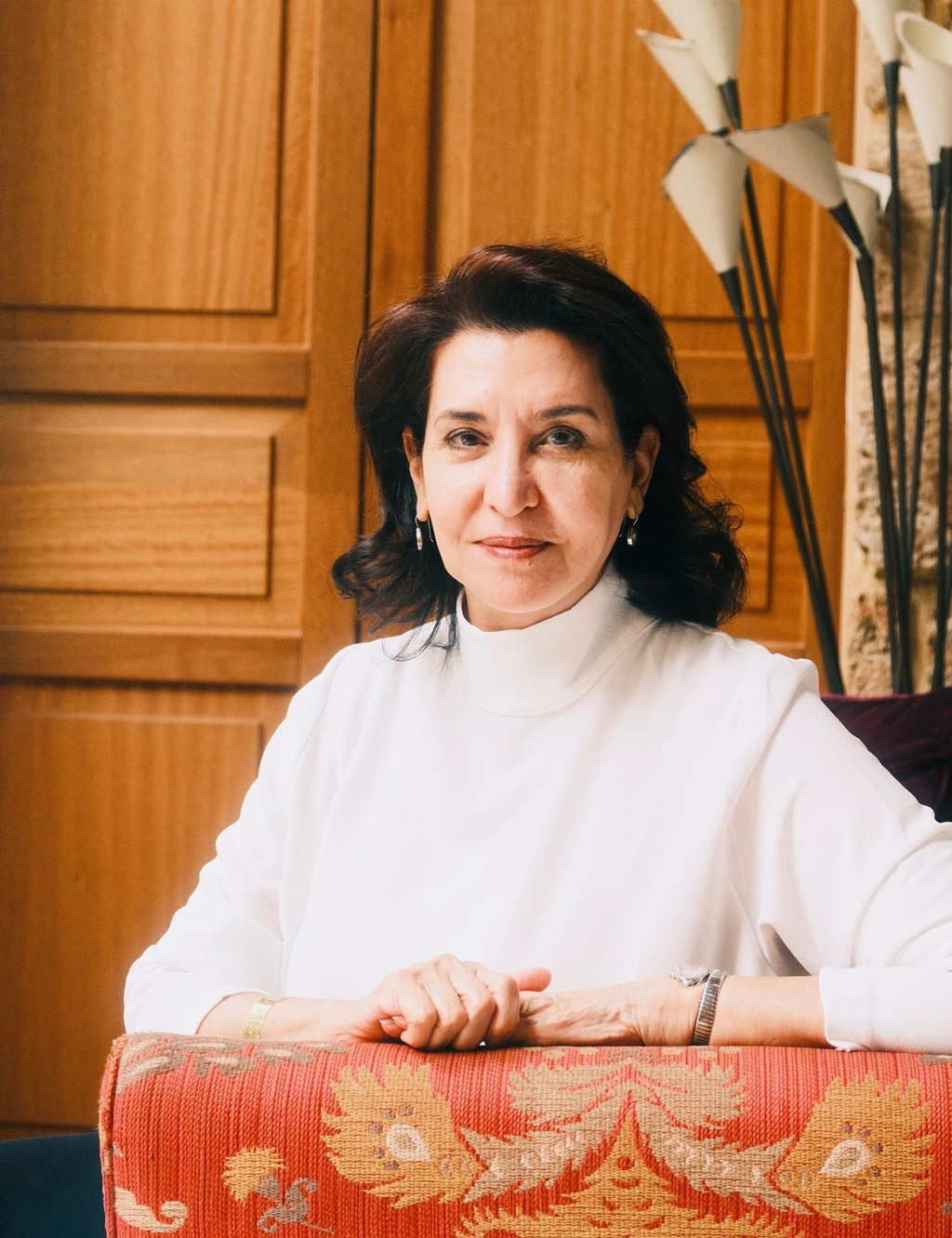Sheikha Altaf Salem Al-Ali Al-Sabah shares her journey towards establishing Sadu House in Kuwait as a home for Bedouin weaving.
Sadu House, a traditional Kuwaiti building, was originally constructed in 1936 by Youssef Al Marzouk, a Kuwaiti merchant. The house, which overlooked the seafront, was built using stone and concrete, making it the first of its kind in Kuwait at the time. In 1938, it was purchased by Shereen Behbehani, who added a new floor and European-style fireplaces. Eventually, the house was acquired by the state in the 1970s. In 1980, it was allocated to the Sadu project and continues to this day in its role as a cultural centre and museum dedicated to preserving and showcasing the traditional Bedouin art of Sadu weaving. Since then, Sadu House has played a crucial role in conserving Kuwait’s cultural heritage while promoting contemporary artistic expression.
- Sadu House in the 1930s
- Sadu House in the 1950s
Sadu House has many dimensions. It is a museum documenting the techniques and history of Sadu weaving. It offers many workshops on weaving, artistic and product development. Outside the premises, it conducts the “Teach the teachers” program to enable schools, particularly art teachers, to teach all students Sadu weaving as part of their art curriculum. Outside Kuwait, it provides teaching and training workshops on Sadu weaving with culture centres in the Gulf, as well as collaborations with UN Refugee agencies to train refugee communities in Egypt.
Sheikha Altaf Salem Al-Ali Al-Sabah is a prominent Kuwaiti royal and cultural patron. She is best known for her role as the driving force behind the preservation of traditional Bedouin weaving heritage in Kuwait. In 1978, Sheikha Altaf co-founded with like-minded Kuwaitis a private initiative to protect and document traditional Bedouin Sadu weavings. In 1991, the initiative evolved into a new entity, the Al Sadu Weaving Cooperative Society, a new collective established under the umbrella of the Ministry of Social Affairs that honours the master weavers as well as the growing textile community in Kuwait. She currently serves as the Patron and Honorary President of Al Sadu Society, housed in the historic Sadu House. Under her leadership, the society aims to preserve, document, and promote Kuwait’s rich textile heritage, connecting both the nomadic weaving traditions of the desert with urban weaving practices.
Sheikha Altaf kindly shared her journey with Garland in February 2025.
✿ Tell us about where you were born and what you wanted to be when you grew up.
I was born in Kuwait. I had a very enlightened, strong grandmother who believed education was very important. She insisted that I, my cousin and then later my two younger brothers, go to Beirut, Lebanon, to study. In the late 50s and 60s, Lebanon had very good schools. I finished high school and then went to the American University of Beirut, one of the prominent universities in the region. I now appreciate my grandmother’s wisdom and push and see her as “ a great lady and a visionary who had this ability to foresee the importance of education, so I’m blessed with that.
✿ What were you studying?
I took my BA in a joint social /culture anthropology major from the American University of Beirut, which was in the 1970s and continues to this day as a centre for excellence in education. I finished my BA and then my master’s MA in Social Anthropology. I enjoyed my study in anthropology and am still interested in understanding cultures, human connection, and development.
✿ Were you looking at your own culture at that stage in your studies?
No, back then, I was involved in various international cultural activities. I joined the University’s Women’s Student Organization. In my second year, I ran for President. AUB had so many different nationalities, reflecting various cultures. I liked my work and succeeded in my personal merit. We organized various functions to showcase different cultural activities, especially those of traditional cultures and music. I still remember vividly myself and a Jordanian colleague in traditional Palestinian dress in support of a Palestinian women and children’s Bazaar.
When I finished my studies, I returned to Kuwait and became a lecturer in anthropology at Kuwait University. It was a great experience and challenge for me as it allowed me to further polish my Arabic as well as translate a lot of my graduate reference books for this teaching coursework.
Teaching helped me to get closer to my young students, whose numbers grew, I believe, due to an interactive approach to class presentations I did, which allowed them to participate and share in class discussions. I really wanted the students to understand and comprehend more than just memorize and take exams. I encouraged students to participate in groups, present and share their knowledge verbally in class. I believe it was this personal empathy that made this approach a success with the students and later on in my interaction with the weavers and artisans with whom I was privileged to work.
In 1979, I was appointed as a board member of the Kuwait National Council for the Arts & Culture. It was interesting to meet peers who were wiser and older and work together on major cultural programs. It was then that my advocacy for cultural preservation grew in focus. My study in anthropology, work in teaching, and cultural endeavours made me very adamant about safeguarding many aspects of the tangible and intangible material culture of Kuwait.
Fortunately, the Kuwaiti government had kept and protected a string of old houses along this Arabian Gulf road by purchasing them from their former owners. Then, the Emir Sheikh Jaber AlAhmad AlSabah allowed the family owners of some of these houses to use them as diwaniyas, a special Kuwaiti traditional meeting place for men. This brilliant idea allowed many of these traditional houses to be well preserved and alive to this day.
In early 1980, as a founding and board member of the Sadu group, I made an effort to search for a place to house the project. I approached the Ministry of Information with a request to allow the use of a particular historic house, which I had noticed was being renovated on the Gulf Road by the Ministry, as offices. I was very concerned about that prospect which, in my opinion, would lose the building’s historic value and appeal. To this day, I strongly believe that traditional houses have a soul and a special energy that speaks of stories of history and culture. This energy certainly does not function well with bureaucracies.
Fortunately, today, this splendid house stands proud as a thriving cultural centre, safeguarding and showcasing Kuwait’s textile heritage.
After the Gulf War in 1990, the house and project were in a sad and dire situation. I had been thinking for some time about how best to sustain our efforts. So that’s when the late Jasleen Dhamija was recommended to me. I called her by telephone and invited her to Kuwait to discuss the future of our safeguarding efforts. I asked her, “This is our work. What is the best framework for sustaining crafts?” She suggested a cooperative, reflecting on her experience and admirable work with crafts in Africa, India, and Iran. She gave us her perceptions on this matter as well as bylaws for sustaining the craft of weaving. We submitted this to the Ministry of Social Affairs in Kuwait. After intensive consultation and a survey done on the future prospects of weaving in Kuwait we were fortunate to get the approval of a formally established new entity for Kuwait’s AlSadu weaving. In this context, it is important to note what Jasleen Dhamija had been stressing: that crafts emerge out of necessity and thrive through demand. They have to be functional within their own social setting. Today, this objective has been achieved through the AlSadu Cooperative Society, where the weaving craft, as well as the art form of Sadu, is thriving within its evolving contemporary context.
With Al Sadu’s new entity, the women weavers became members and shareholders and were happy to be viewed as artists. Traditionally, tribal Bedouin women were very proud and boastful of their work. Today, they are admired as artisans and artists.
The culture and social fabric of Kuwait is connected to both the desert and the Sea. Much of our value system derives from a tribal culture that reflects perseverance, courage and generosity. The famous Bedouin sword war dance by men, the arda, is a vibrant part of our contemporary culture, much as sadu weaving.
✿ So, what do you think is the particular value of Sadu in Kuwait?
That is a very good question. I believe Sadu today is an essential part of Kuwait’s national identity and creative artistic expression.
Kuwait’s culture is a very interesting merger of Bedouin culture, the culture of the desert, and the sea. These two cultures come together in a very particular way and strengthen each other. That’s why we have the strong energy of traders, seafarers, pearl divers, and fishermen, as well as the Bedouin values of perseverance and courage as reflected in the vibrant, boastful art of Sadu weaving as well as the bold arda, the desert sword war dance, still performed today by men on special social occasions.
I do appreciate how the women in the past could produce something very functional and basic, such as weaving, yet add colour and adornment to it and their lives.
There are value systems that have to be preserved. Craft, for me, is a story of man, nature and adaptability. Adaptability is the functionality, the need, and the ingenuity. You could do something very simple. These women could have produced very basic, black-and-white work. Why did they need to make it ornate? In researching my book on ibjad (tent dividers), I talked to a lot of men about tent dividers, which always faced the men’s section of the tent. They told me that the women were poets through their weaving. Another interesting point they told me was that these dividers showcased the manual ability of the woman. So a lot of marriages took place because of them. When the men saw these fine tent dividers, they would think, “Oh, these women are very good at weaving”. So that means they are very good also as homemakers. They showcased their tribal sense of pride and belonging.
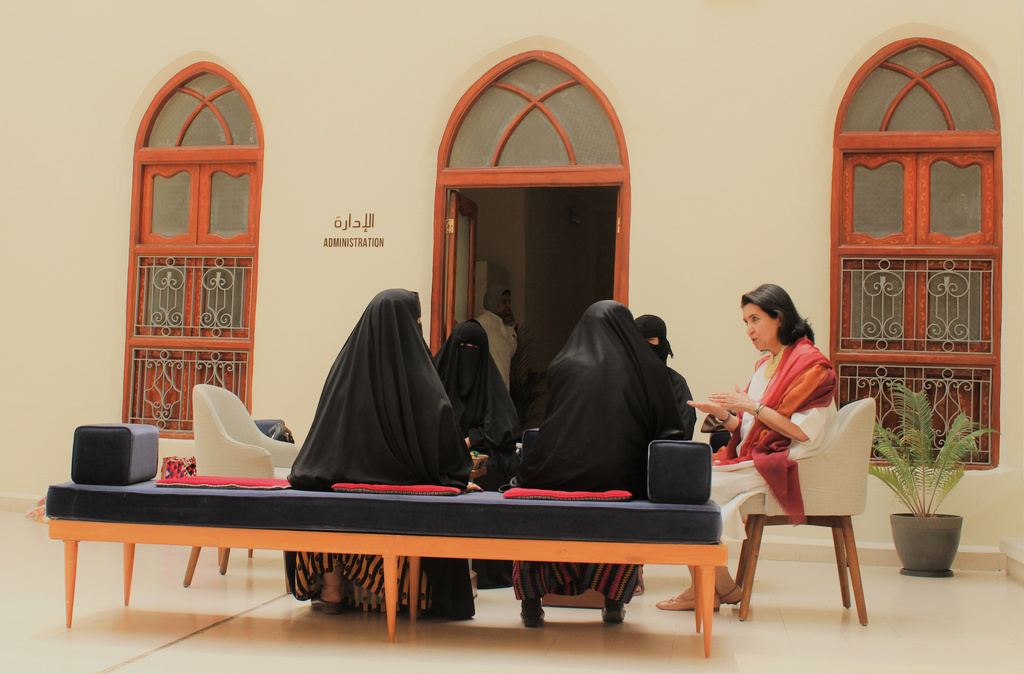
✿ Can you say something about the Islamic dimension of this value of beauty?
Weaving began as very functional. Most of the woven items were just black and brown. They avoided white because it would soil. With time, I believe women would have said, “We want something better and colourful that brightens our life and showcases our ability.” There is something inherent in human beings, man or woman, that yearns for some beauty in life. In Islam, there was this important saying by the prophet, “God is beautiful and loves beauty”, which many art scholars consider the basis for Islamic art.
I believe God bestowed in human beings this yearning for beauty. For that, we are blessed.
This value for beauty is reflected in many of these woven pieces and in many Islamic art and architecture. The intricate work and details we see in ancient buildings and everyday plates are done because they wanted to see beauty in things. I mean, architecture is like weaving. It could have been just plain stone and mud walls. Why did people want to add such intricate designs? I believe God bestowed in human beings this yearning for beauty. For that, we are blessed.
The anthropologist Francis Boas has always been a mentor to me. When you look at the weavings in Peru, American Navaho, Turkish Kilims and Bedouin nomadic weavings, you see many similarities. Franz Boas explains this to the sameness of the human mind and nature. So, in the tribal nomadic style of life in the desert, they have very limited resources. They all use the nomadic ground loom that dictates only simple geometric patterns. They can’t do flora designs like in the standing looms in Iran, for example, where you have elaborate florals, birds and animals. So again, art is dictated by the human mind and its surrounding space.
✿ What role do you think Sadu House can play, not just within Kuwait but also with other countries?
Today, we have a lot of exchange programs, collaborations and teaching mentorships. These initiatives are very important tools of connection and weaving, which, in essence, is all about the connection of threads through the interchange of warp and weft .
In this, I have to give credit to the present Chairperson of Sadu Society, Bibi AlSabah. In 2020, she took the AlSadu internationally to the UNESCO level. In 2022, AlSadu Society was accredited as a recognized NGO, as well as recognizing its educational program with the UNESCO “Train the Trainers “ program. My earlier work on the educational program, with help from experts like UK weaver Rhona Critchonand USA textile artist/ teacher Leslie Robertson, helped pave the way for an art program and curriculum that was incorporated in the art curriculum of the Kuwait Government schools in 2018. All these steps needed further development that Bibi AlSabah, through her diligence and effort, carried forward to be recognized within the UNESCO “Train the Trainers” educational program. These effective steps were very important milestones for the AlSadu Society.
In April 2025, Kuwait will celebrate its new status as a World Craft City.
Visit alsadu.org.kw and follow @saduhouse.
Learn more about World Craft Cities.


